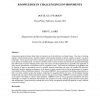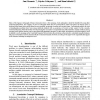114 search results - page 10 / 23 » Identifying Dynamic Sequential Plans |
EOR
2006
13 years 8 months ago
2006
CT In this paper some experimental sequential models for the simulation of trip-chains are presented; the models have been calibrated on the base of a survey made in a medium-sized...
COMPSEC
2004
13 years 8 months ago
2004
Identifying the intentions or attempts of the monitored agents through observations is very vital in computer network security. In this paper, a plan recognition method for predict...
CI
2005
13 years 8 months ago
2005
Autonomous agents that learn about their environment can be divided into two broad classes. One class of existing learners, reinforcement learners, typically employ weak learning ...
AAAI
2010
13 years 10 months ago
2010
Multi-Agent Plan Recognition (MAPR) seeks to identify the dynamic team structures and team behaviors from the observations of the activity-sequences of a set of intelligent agents...
LREC
2008
13 years 10 months ago
2008
Many of the Japanese ideographs (Chinese characters) have a few meanings. Such ambiguities should be identified by using their contextual information. For example, we have an ideo...


